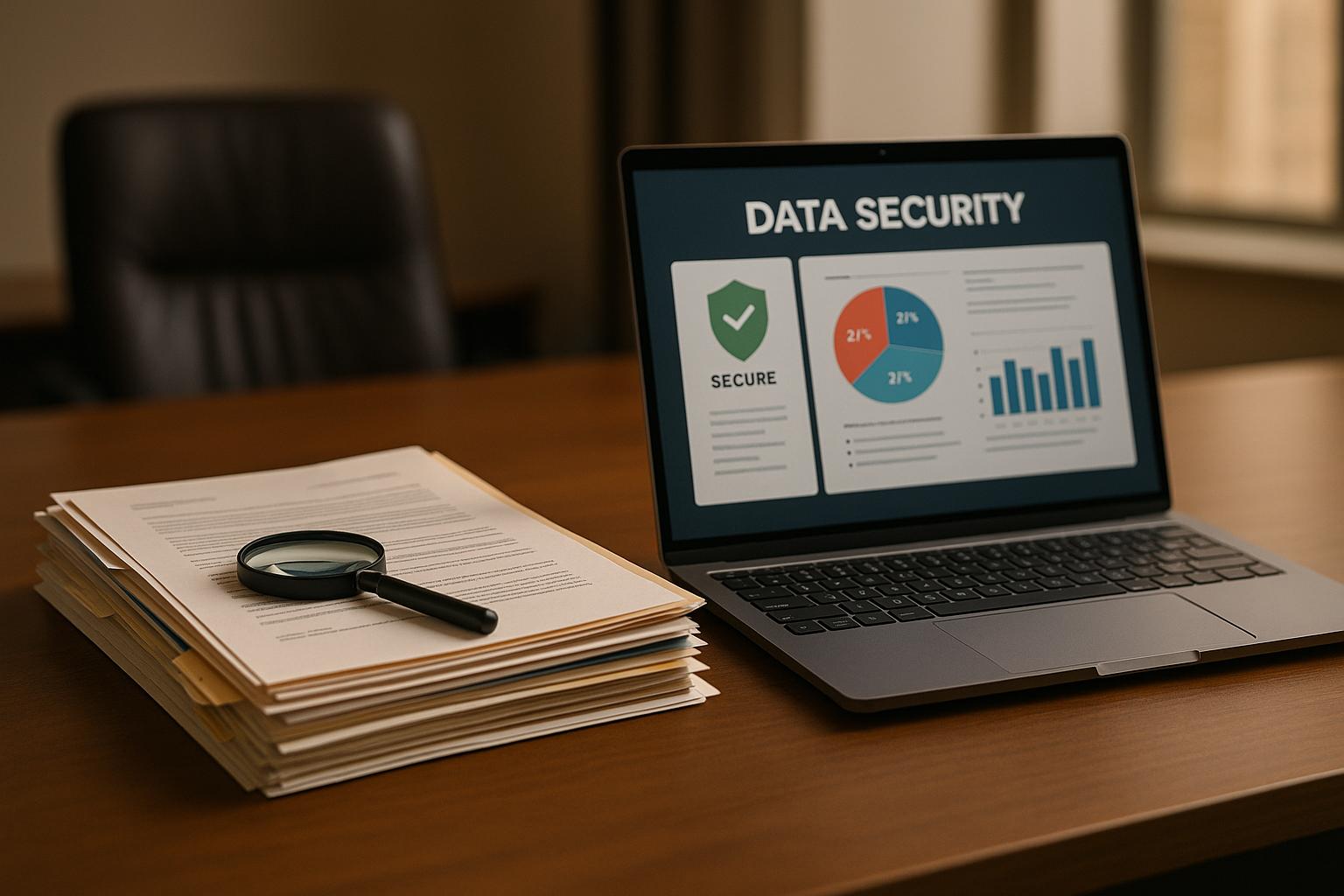How to Audit Vendor Data Security for M&A Deals

When companies merge or acquire another, they inherit not just assets but also cybersecurity risks tied to the target company’s vendors. Conducting vendor data security audits is a critical part of due diligence to identify risks, ensure compliance, and protect the deal’s value.
Key Steps to Vendor Data Security Audits:
- Pre-Acquisition: Review vendor policies, assess high-risk vendors (e.g., cloud providers, payment processors), and analyze breach history to identify potential risks early.
- Acquisition Phase: Perform in-depth audits, including penetration testing and compliance checks (e.g., SOC 2, ISO 27001). Evaluate vendor contracts and request updated assessments if needed.
- Post-Acquisition: Align vendor security practices with your organization, update contracts, monitor vendors consistently, and maintain compliance.
Tools to Simplify Audits:
- NIST Cybersecurity Framework: Guides security evaluations.
- SOC 2 Reports & ISO 27001 Certifications: Streamline compliance checks.
- Automated Platforms: Tools like SecurityScorecard or BitSight provide real-time risk monitoring.
- Penetration Testing: Identifies vulnerabilities in vendor systems.
Why It Matters:
Neglecting vendor security can lead to breaches, regulatory fines, and reduced deal value. By integrating findings into negotiations and post-deal planning, you can safeguard your investment and ensure smoother integration.
For more effective audits, consider partnering with financial advisory firms like Phoenix Strategy Group. They combine technical expertise with financial insights to evaluate risks, align compliance, and support long-term security monitoring.
Takeaway: Vendor security audits are not just a technical exercise - they directly impact deal success, compliance, and operational stability.
3 Key Phases of Vendor Data Security Auditing in M&A
Vendor data security auditing during mergers and acquisitions (M&A) is closely tied to the deal’s lifecycle, with each phase addressing specific goals and requiring varying levels of scrutiny. By understanding these phases, acquirers can prioritize resources effectively and maintain high security standards throughout the process. Each phase builds on the previous one, ensuring thorough security diligence from start to finish.
Pre-Acquisition: Risk Assessment and Initial Review
The pre-acquisition phase focuses on identifying potential risks early in the process. This preliminary evaluation helps determine whether vendor-related security issues could jeopardize the deal or lead to significant remediation expenses.
At this stage, acquirers should conduct a high-level review of the target company’s vendor security policies and frameworks. Key areas to assess include the vendor management program, how vendor risk levels are classified, and the onboarding processes for new vendors. Reviewing vendor risk registers, which categorize suppliers based on their access to sensitive data and their importance to the business, is essential.
High-risk vendors - such as cloud service providers, payment processors, customer relationship management platforms, or those with access to personally identifiable information (PII) or financial data - should be prioritized. These vendors pose the greatest risks to business continuity and compliance.
Another critical step is reviewing breach records from the past 3–5 years. This analysis should include both successful breaches and attempted attacks, as well as policy violations and compliance lapses. Understanding how the target company handled these incidents provides insight into their incident response capabilities and overall vendor management maturity. The findings from this phase lay the groundwork for more thorough evaluations during the acquisition phase.
Acquisition: Complete Security Audits
During the acquisition phase, the focus shifts to comprehensive security audits. This involves detailed technical assessments and extensive documentation reviews that go far beyond the initial screening.
Penetration testing and vulnerability assessments are key activities in this phase. These tests, along with a review of compliance documentation such as SOC 2, ISO 27001, and PCI DSS reports, help evaluate the security measures of each vendor. Network segmentation is another critical area, as it’s important to understand what data vendors can access and through which channels.
Compliance verification is a major focus during this stage. Acquirers should thoroughly review vendor contracts and related documents to confirm adherence to industry standards. Third-party security questionnaires and audit reports offer additional insights into vendor practices, covering areas like access controls, encryption, backup procedures, and business continuity plans.
If existing assessments are outdated - typically more than 12 months old - this is the time to request updated evaluations. These detailed audits provide the information needed to make informed strategic decisions about the deal.
Post-Acquisition: Integration and Monitoring
The post-acquisition phase centers on integrating vendor security frameworks and establishing robust monitoring systems to ensure long-term security and operational success.
Integration involves aligning the acquired company’s vendor security policies with the acquirer’s existing standards. This may include updating vendor contracts, deploying new security monitoring tools, and standardizing incident response procedures. The goal is to unify security practices across the combined organization without disrupting key vendor relationships.
Ongoing monitoring is crucial for maintaining vendor security performance over time. Automated scanning tools, regular review cycles, and performance dashboards help track security metrics. For high-risk vendors, quarterly reviews can provide an additional layer of oversight.
Compliance monitoring becomes a routine task in this phase, especially in regulated industries where vendor compliance directly impacts the organization’s regulatory standing. Regular audits, updated assessments, and continuous tracking ensure that standards are upheld.
Establishing vendor lifecycle management processes is another key component. This includes standardized procedures for onboarding new vendors, conducting regular security reassessments for existing ones, and managing offboarding when vendor relationships end. These practices help maintain consistent security standards as the organization grows, protecting both compliance and the value of the deal in the long run.
Core Step for Conducting Vendor Data Security Audits
Start your vendor data security audits by creating a detailed inventory of all vendors who have access to your systems, data, or facilities. This step is essential for identifying vendors involved in your M&A activities. Think of this inventory as the foundation for all subsequent efforts to evaluate and manage vendor risks.
Vendor Risk Profiling
Once you’ve compiled your inventory, the next step is vendor risk profiling. This involves assessing the potential risks each vendor could pose to the security of the transaction. Use your inventory as a guide to evaluate each vendor’s risk profile, which will serve as a critical reference point throughout the M&A process.
Tools and Methods for Vendor Security Audits
To meet tight M&A timelines, audit teams need reliable tools that streamline the entire process - from early risk profiling to ongoing monitoring after acquisition. Below, we’ll explore some key tools and methods that can make vendor security audits more efficient and effective.
Security Audit Tools Overview
A great starting point for structuring audits is the NIST Cybersecurity Framework, which organizes efforts into five key areas: Identify, Protect, Detect, Respond, and Recover. This framework provides a solid foundation for assessing vendor security practices.
SOC 2 Type II reports are another valuable resource, particularly for evaluating compliance in areas like security, availability, processing integrity, confidentiality, and privacy. When vendors supply up-to-date SOC 2 Type II reports, they simplify the audit process by offering pre-documented control evaluations.
For ongoing oversight, automated risk scoring platforms like SecurityScorecard and BitSight are indispensable. These tools provide real-time monitoring, which is especially useful during lengthy M&A processes when a vendor's security posture may change.
In international transactions, ISO 27001 certification is a crucial marker. Vendors with this certification have already undergone rigorous third-party audits of their information security management systems, making them easier to evaluate.
Finally, penetration testing - conducted by firms such as Rapid7 or Qualys - offers deep insights into vulnerabilities. Reviewing recent penetration test results can reveal how well a vendor identifies and addresses security gaps.
Tool and Framework Comparison
Each tool and framework serves a different purpose, so selecting the right combination is essential. For example:
- The NIST framework offers broad, structured guidance for comprehensive audits.
- Certifications like SOC 2 and ISO 27001 simplify evaluations when vendors already meet these standards.
- Automated platforms excel in providing continuous monitoring and quick insights, which is critical in fast-moving M&A scenarios.
When choosing tools, consider factors like cost, scalability, and how easily they integrate with your existing audit process. Some tools, such as automated platforms, operate on a subscription model, offering ongoing oversight with minimal internal effort. Others, like penetration testing, may require more hands-on involvement or external consulting.
A layered approach often works best. Use automated platforms for initial screenings, frameworks like NIST for in-depth assessments, and certifications to streamline evaluations. This combination ensures a thorough and flexible vendor security audit process throughout the M&A lifecycle.
sbb-itb-e766981
Using Vendor Security Findings in M&A Decisions
Once you've gathered vendor security data, the next step is turning those findings into actionable business decisions. These insights can directly influence negotiations, valuations, and integration strategies.
Security findings aren’t just technical details - they’re a form of strategic intelligence. A vendor with strong security practices might support a higher valuation, while significant vulnerabilities could lead to price adjustments or even deal restructuring. The challenge is to clearly communicate these findings to stakeholders and use them to shape key business decisions.
Documenting Security Findings for Stakeholders
After completing the audit, it’s crucial to present the findings in a way that’s clear and actionable for all stakeholders.
- Executive summaries should focus on the essentials: overall risk levels, potential financial impact, and recommended actions. Include a risk rating, estimated costs tied to security issues, and a timeline for addressing them. This ensures decision-makers quickly grasp the critical takeaways.
- Risk heatmaps are a powerful tool to visualize a vendor’s security posture. They plot the likelihood of incidents against their potential business impact, helping stakeholders quickly identify the most pressing risks and prioritize post-acquisition actions.
- Technical reports should go deeper, listing specific findings alongside remediation timelines, metrics like the number of critical vulnerabilities, response times, and compliance statuses (such as SOC 2 or ISO 27001 certifications).
- Standardized scoring systems bring consistency to vendor evaluations. For example, a numerical scale (e.g., 1 to 100) can weigh security factors based on your organization’s priorities. A financial services company might prioritize encryption, while an e-commerce business could focus more on uptime and availability.
- Financial impact assessments translate technical risks into business terms. Calculate potential costs from security failures, such as regulatory fines, customer notification expenses, downtime, and reputational damage. Compare these costs to the investment needed to bring vendor security up to par.
By documenting these insights effectively, you can ensure that vendor practices align with your company’s policies and priorities.
Aligning Vendor Compliance with Acquirer Policies
Once the findings are documented, the next step is aligning vendor practices with your internal security policies to protect the transaction and future operations.
- Policy gap analysis is essential. Compare the vendor’s practices to your standards in areas like access controls, data retention, incident response, and employee training. This analysis will guide your post-acquisition integration efforts.
- Integration planning should address both immediate fixes and longer-term security upgrades. Incorporate these timelines into your overall integration strategy and budget accordingly.
- Resource allocation for security improvements can be a significant expense. Plan for investments in new tools, staff training, system upgrades, or consulting services. Evaluate whether it’s more cost-effective to enhance the vendor’s systems or migrate them to your existing platforms.
- Regulatory compliance alignment is often complex. For example, a vendor operating under GDPR might need additional measures to meet CCPA requirements, or vice versa. Map out all applicable regulations and create a unified framework that meets the strictest standards.
- Cultural integration of security practices is just as important. Use targeted training to introduce new protocols and develop communication strategies to explain the rationale behind security requirements. Clear guidance will help ensure smooth adoption.
Vendor security alignment doesn’t end with the acquisition. Regular security reviews, policy updates, and open communication between your security team and the vendor will help maintain and strengthen security practices. This ongoing effort not only protects your operations but also enhances the overall value of the merger or acquisition.
Using Financial Advisory Expertise for Vendor Data Security Audits
Vendor security audits in mergers and acquisitions (M&A) require a mix of technical know-how, financial understanding, and regulatory insight. Financial advisory firms bring a distinct edge to this process, combining their M&A expertise with technical capabilities to provide thorough risk evaluations.
These firms are uniquely positioned to interpret how security issues can impact finances, influence deal structures, and drive post-acquisition integration costs.
Role of Advisory Firms in Vendor Security Audits
Financial advisory firms play a critical role as strategic partners during vendor security audits, connecting technical findings with broader business decisions. Their contribution goes beyond crunching numbers - they evaluate risks and provide strategic recommendations.
Using proprietary methodologies, these firms assess vendor security risks with a focus on compliance, regulatory landscapes, and the acquiring company's existing security setup. By leveraging advanced tools and data analytics, they efficiently process large datasets and pinpoint key risk factors.
Their coordination during due diligence ensures that security audits are seamlessly integrated into the overall transaction review. This often involves working closely with legal teams on contracts, collaborating with technical teams on system integration plans, and aligning security findings with valuation considerations.
For multi-jurisdictional deals, advisory firms provide essential regulatory expertise. Their understanding of different regulatory systems helps identify compliance gaps that could lead to liabilities after the acquisition. By translating technical findings into actionable insights, they ensure executives, board members, and investors are well-informed and prepared to make sound decisions.
Benefits of Partnering with Phoenix Strategy Group

Building on this advisory expertise, Phoenix Strategy Group offers tailored solutions that combine technical and financial analyses. With a strong background in M&A advisory and advanced data engineering, they are well-equipped to handle vendor security audits.
Phoenix Strategy Group’s experience in M&A enables them to evaluate how security findings can affect deal structures and valuations. Whether it’s an asset purchase, stock acquisition, or merger, they customize their methods to address the unique risks and opportunities of each transaction.
Their data engineering capabilities allow for real-time monitoring by integrating diverse data sources, making audits more efficient and accurate. Additionally, their financial models incorporate security risks into overall transaction valuations. These models help acquirers understand the potential costs of security risks and remediation, ensuring informed decisions about deal pricing and structure.
Beyond the initial audit, Phoenix Strategy Group supports clients through their Fractional CFO services. This includes creating security-focused key performance indicators and maintaining ongoing monitoring to prioritize vendor security throughout the integration process.
With their proprietary data and technology platform, Phoenix Strategy Group delivers advanced vendor risk analysis, providing critical insights for strategic decisions. Their expertise in fundraising further enhances deal financing by aligning security risk insights with broader financial strategies.
Key Takeaways for Vendor Data Security Audits in M&A
Vendor data security audits play a crucial role in the success of mergers and acquisitions (M&A), directly influencing deal valuations, timelines, and integration expenses. Given their complexity, these audits require a methodical approach that balances technical precision with financial insight.
A three-phase audit framework - covering pre-acquisition risk assessment, detailed acquisition audits, and post-acquisition monitoring - serves as the cornerstone of effective vendor security evaluations. This structured approach ensures that every stage of the process is thoroughly addressed.
Documentation and compliance verification are essential for successful vendor audits. Organizations need to assess not only current security protocols but also past incident records, data management practices, and third-party contractual obligations. These factors can significantly impact financial liabilities, as they often dictate the scope and cost of remediation efforts.
Leveraging advanced audit tools and frameworks can simplify the evaluation process and provide clear, actionable results. However, the real value lies in translating technical findings into strategic insights that can guide decision-making and advisory recommendations.
Financial advisory expertise acts as a bridge between technical assessments and strategic planning. By incorporating regulatory compliance, risk quantification, and valuation analysis, financial advisors ensure that security findings are seamlessly integrated into deal structures. Their collaboration with legal teams, technical experts, and executive stakeholders is key to aligning security considerations with broader transaction goals.
The post-acquisition phase is critical for ensuring the long-term effectiveness of vendor security measures. This involves setting up continuous monitoring systems, embedding security metrics into performance dashboards, and maintaining compliance standards. These efforts require ongoing attention and oversight.
Establishing strong post-acquisition monitoring not only supports compliance but also fosters strategic partnerships that improve audit outcomes. For organizations aiming to maximize the impact of their vendor security audits, working with experienced advisory firms like Phoenix Strategy Group can provide access to specialized M&A expertise, advanced data engineering, and robust financial modeling. Their integrated approach ensures that vendor audits contribute to both the immediate and long-term success of the transaction, rather than serving as a mere compliance exercise.
Approach vendor security as a strategic priority to guide decisions on risk tolerance, remediation investments, and integration strategies effectively.
FAQs
What are the main vendor data security risks during M&A deals, and how can they affect the transaction?
When companies go through mergers and acquisitions, vendor data security risks can become a serious concern. These risks often include cybersecurity weaknesses, data breaches, inconsistent security protocols, and supply chain vulnerabilities. If not addressed, they could expose sensitive information, complicate compliance efforts, and even result in regulatory penalties.
The consequences of these risks are far-reaching. They can cause financial setbacks, delay the deal’s closing, and tarnish the company’s reputation in the long run. That’s why performing a detailed data security audit is essential. It helps uncover potential vulnerabilities and ensures the transaction process stays on track and secure.
How can companies verify that vendor security practices meet their standards after an acquisition?
When bringing a new vendor on board after an acquisition, making sure their security practices align with your company’s standards is a must. Start by conducting thorough cybersecurity due diligence. This means diving into their security controls, policies, and incident response plans to spot any weaknesses that could pose a risk.
Beyond that, make sure security requirements are clearly outlined in the acquisition agreement. It’s also wise to set up ongoing monitoring and regular audits to ensure their practices stay in sync with your company’s protocols. Consistent communication and oversight throughout the process are crucial for keeping things secure and ensuring a smooth integration.
How do financial advisory firms support vendor data security audits during M&A transactions?
Financial advisory firms are essential players when it comes to vendor data security audits in mergers and acquisitions (M&A). Their role? Bringing cybersecurity know-how to the table. They dig deep to spot vulnerabilities, evaluate risks, and ensure everything aligns with the necessary regulations. This not only minimizes potential liabilities but also helps protect the deal's overall value.
These firms take charge of technical assessments, identifying risks early in the process to keep due diligence running smoothly. Beyond that, they play a key role in post-transaction security efforts, ensuring the acquired company's data assets are seamlessly integrated and remain protected. By addressing these challenges upfront, they set the stage for a smoother, more secure M&A process.




